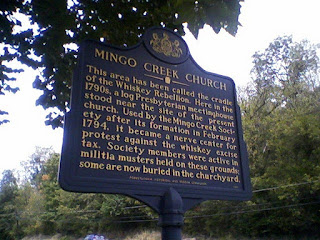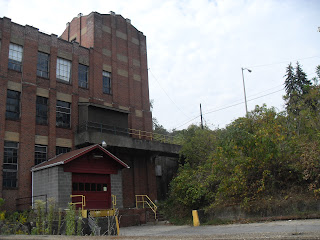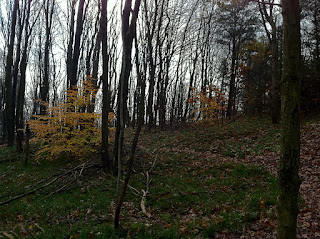 |
| Click to enlarge. |
Friday, November 25, 2011
Sunday, November 20, 2011
Mayview State Hospital
 |
| These pictures were taken in September of 2010. The first time they were published online, I got a message from The History Channel asking permission to use them. |
Saturday, November 19, 2011
McDonald Trestle
 |
| This is the the McDonald Trestle, a well known landmark along the Montour Trail. |
 |
| The Montour Trail, by comparison, does a semicircle around the Pittsburgh urban area from Clairton, on the Monongahela, to Coraopolis, on the Ohio. |
 |
| Both are "rail trails," old coal railroads that pass through the grittier areas of small towns, old mining villages, and industrial complexes. |
 |
| And yet, they pass through open countryside, too, some of it pleasant. The bleak November landscape is a companion on the journey. |
Sunday, November 13, 2011
The Power of Suggestion
 |
| November at Hillman State Park, aka Bavington Game Lands: my constant retreat. |
At a dinner party last evening, an acquaintance asked me where I do most of my hiking. I told him that lately I've been pretty much restricted to the little-known Hillman State Park. He asked, a little incredulously, "Do you go out there alone?" When I told him that I do, he said, "The woods is kind of spooky out there, isn't it?" My reply was dismissive. "Oh, poorly reclaimed strip mines are always kind of spooky. It's a beautiful place." He wasn't convinced. Then my acquaintance proceeded to tell me about a friend of his who won't ride his mountain bike at Hillman anymore because the last time he was there by himself, he got the distinct and frightening impression that he was being chased by someone he couldn't see.
Of course, I explore "eerie" places just for fun. If you're frightened by bleak countryside and rundown buildings, then Southwest Pennsylvania is no place for you. You'd have to stick to a few brightly lit suburban shopping centers and upscale neighborhoods, but these too are beleaguered islands in a sea of old towns, old factories, old countryside. Some of it's scenic--even lovely--but especially from November through April, much of this region is a little ghostly. And so, as I explored a new area of Hillman today, I couldn't help but find it just a little bit spookier than usual. I guess it's just the power of suggestion.
It always sounds as if there's someone following you in the woods in late autumn. Leaves fall. Animals rattle the dry vegetation on the ground. The wind blows. I only chanced across three cyclists on the trails today, despite the fine weather. It was a little creepy, but I enjoyed the "exposed" feel of crossing large, grassy clearings and leafless gray woods. Every season has its beauty, and every place does, too...if your eyes are open to it.
Saturday, November 12, 2011
The Rev. Dr. John Anderson, Absentminded Scotsman
 |
| Here we are again at the famed Service Church in Beaver County. Notice how the cemetery rises steeply up the hillside beyond. The two little outbuildings on the right are indeed outhouses. |
The Rev. Dr. John Anderson came over from Scotland with his aging mother, who died crossing the ocean and was buried at sea. Anderson tried to land himself a parish in the Philadelphia area, but despite the lack of clergy in those days, he couldn't get hired. Folks didn't like him. He was a small, scholarly man with a high-pitched voice. Most found him too otherworldly.
And so he made for the furthest frontier, where he eventually got a position at the fledgling Service United Presbyterian Church. Since he was such an academic type, his superiors asked him to teach classes for clergy in training. (Up to this point, clergy training had been done under the apprenticeship model.) And so he lectured four hours a day in addition to his parish duties.
It's said that he was an absentminded professor. Once, while riding on horseback to an ecclesiastical convention, he was engrossed in a book, and he allowed the horse to simply follow the road in front of it. As the sun began to set, he looked up and realized that he was lost. He hurried to the door of the nearest house and knocked. His wife opened the door; it was his house at Service Church. Left directionless, the horse had walked in circles for hours and never taken the dithering Scotsman far from home.
Saturday, November 5, 2011
Service Church, 1790
Friday, November 4, 2011
The Orb
I'm a rationalist. I don't believe in miracles. I don't believe in ghosts, or apparitions, or specters. I don't believe in phantoms, or revenants. That's not to say that I'm a pure empiricist. I value mystery and uncertainty. "There are more things in heaven and earth, Horatio, than are dreamt of in your philosophy." But I remain skeptical of the supernatural.
Here's my problem. I live in a 150 year old farmhouse in Allegheny County. Ugly, poorly constructed subdivisions have grown up around the place. But we have nearly a full private acre, which we treat like a miniature farm. The whole compound is separated from suburbia by an old privet hedge. And inside, we've got a large garden, clotheslines, huge composting works, a few outbuildings. I have my den in a little back bedroom, the only room in the house with only one window. The panes of glass are old and rippled; they refract light unevenly like the surface of a pond--except without motion. I walked into my den this evening. All was dark, but I refrained from turning on the light because I noticed a strange square of light on the ceiling. The square was about two feet by two feet, and it stood in a place where I had never seen light before. It was rippled, as well, just like the light that passes through the old window. I thought, "Hmm, the moonlight is reflecting off something on the ground outside, through the window, and onto the ceiling. Strange."
I stood in the dark beneath the square of light, and I waved my hand between the light and the window, but my hand didn't cast a shadow. As I puzzled, unable to find the source of the light, I started to grow uneasy. I muttered something like, "This is a little creepy." No sooner had I spoken than the square of light began to roll away. That's to say, the westernmost end of the square receded into the easternmost end, as if a door were closing it out. In a minor state of alarm, I fumbled for the light switch, but before turning on the overhead light, I noticed that there was indeed light entering the window and hitting the wall behind me in a much larger, dimmer square. Very unlike the light I'd seen on the ceiling.
Twice this evening I've returned to the den to see if the square of light was back on the ceiling. It wasn't. Now I'm at a loss. I want to find a logical, scientific explanation, and I refuse to be frightened in my own den. At all cost, I have to love this place. I'm locked into a mortgage the likes of which I never expected, and lord knows no fool would ever buy this old barn with its crumbling bricks and sagging floors. There have been strange things here before: an occasional thumping noise, a tightly closed door that I know I left open; an electric light left on in a room where I know all was dark. My wife and kids have never noticed these things. I live with them and simply say, jokingly, "Okay, Hickmans! I know you're still here!" But these lights are too weird.
No one really much reads this blog. I don't keep the blog for its readership. An occasional reader stumbles across it, not more than three or four per month. The blog is mostly just a personal record of my excursions. But does anyone out there want to tell me what the weird light's about?
Here's my problem. I live in a 150 year old farmhouse in Allegheny County. Ugly, poorly constructed subdivisions have grown up around the place. But we have nearly a full private acre, which we treat like a miniature farm. The whole compound is separated from suburbia by an old privet hedge. And inside, we've got a large garden, clotheslines, huge composting works, a few outbuildings. I have my den in a little back bedroom, the only room in the house with only one window. The panes of glass are old and rippled; they refract light unevenly like the surface of a pond--except without motion. I walked into my den this evening. All was dark, but I refrained from turning on the light because I noticed a strange square of light on the ceiling. The square was about two feet by two feet, and it stood in a place where I had never seen light before. It was rippled, as well, just like the light that passes through the old window. I thought, "Hmm, the moonlight is reflecting off something on the ground outside, through the window, and onto the ceiling. Strange."
I stood in the dark beneath the square of light, and I waved my hand between the light and the window, but my hand didn't cast a shadow. As I puzzled, unable to find the source of the light, I started to grow uneasy. I muttered something like, "This is a little creepy." No sooner had I spoken than the square of light began to roll away. That's to say, the westernmost end of the square receded into the easternmost end, as if a door were closing it out. In a minor state of alarm, I fumbled for the light switch, but before turning on the overhead light, I noticed that there was indeed light entering the window and hitting the wall behind me in a much larger, dimmer square. Very unlike the light I'd seen on the ceiling.
Twice this evening I've returned to the den to see if the square of light was back on the ceiling. It wasn't. Now I'm at a loss. I want to find a logical, scientific explanation, and I refuse to be frightened in my own den. At all cost, I have to love this place. I'm locked into a mortgage the likes of which I never expected, and lord knows no fool would ever buy this old barn with its crumbling bricks and sagging floors. There have been strange things here before: an occasional thumping noise, a tightly closed door that I know I left open; an electric light left on in a room where I know all was dark. My wife and kids have never noticed these things. I live with them and simply say, jokingly, "Okay, Hickmans! I know you're still here!" But these lights are too weird.
No one really much reads this blog. I don't keep the blog for its readership. An occasional reader stumbles across it, not more than three or four per month. The blog is mostly just a personal record of my excursions. But does anyone out there want to tell me what the weird light's about?
Subscribe to:
Posts (Atom)






















